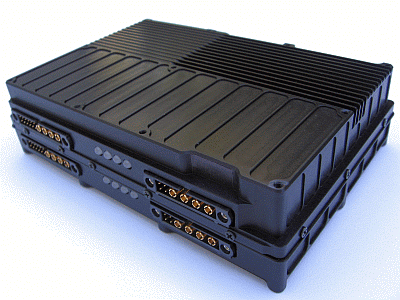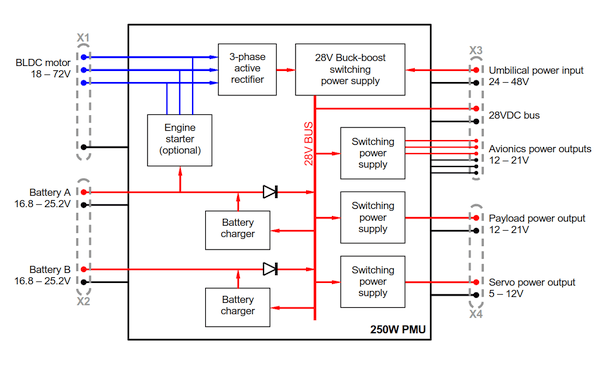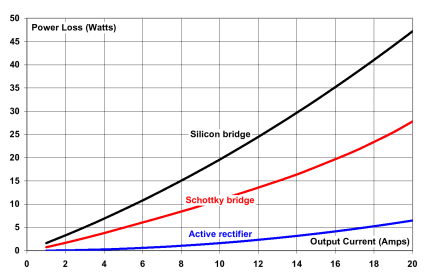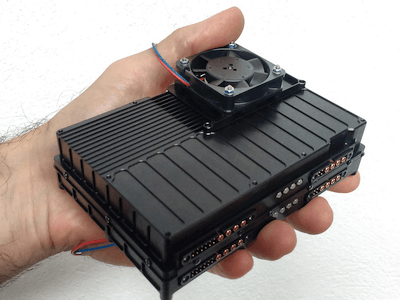On this page: Functional description | Product resources | Active rectifier | Polyphase switching converter
250W Power Management Unit

250W Power Management Unit
The 250W Power Management Unit provides on-board electrical power generation, battery management and power distribution for small to medium-sized UAVs.
The 250W PMU converts 3-phase AC from a BLDC motor into a set of regulated DC outputs suitable for powering a vehicle's avionics, servo and payload demands. Output rails are maintained from battery power whenever electrical power generation is not occurring.
The PMU has dual battery inputs with automatic and glitch-free switchover between the two. Each battery input has its own battery charger. An umbilical input ensures that batteries are not depleted during pre-flight checks prior to take-off.
Output rails and battery chargers are user-configurable for voltage, allowing the PMU to be adapted to your vehicle's voltage plan, rather than the other way around.
The 250W PMU was developed in partnership with Currawong Engineering.
Features:- Buck-boost converter allows electrical power generation over 4:1 RPM range.
- Multiple independent, individually user-programmable power outputs:
- Avionics: 12 - 21 VDC, 7.5 Amps (120W max.)
- Payload: 12 - 21 VDC, 7.5 Amps (120W max.)
- Servo: 5 - 12 VDC, 10 Amps (120W max.)
- Outputs are battery-backed and switchable (on/off) via hardware signal or remotely via command.
- Dual (redundant) battery support. The PMU includes two independent and identical battery chargers. Supported battery types include:
- LiPo: 5S, 6S
- LiS: 8S, 9S, 10S
- LiFe: 6S, 7S
- Industry-standard 28 VDC output (available during power generation and when the PMU is connected to umbilical power).
- RS232 and CAN control and monitoring interfaces provides extensive monitoring and reporting of voltages, currents, battery charge status, temperatures.
- Optional engine starter may be activated locally via a momentary push-button switch, or remotely via command to facilitate in-flight engine restarting (Currawong Engineering variant).
- Weight: 290g (10.2oz).
- Dimensions: 124.4 x 85.0 x 32.5mm
The 250W PMU integrates seamlessly with Currawong Engineering's Corvid-29 and Corvid-50 engines when purchased as part of an EFI powertrain solution. Contact Currawong Engineering to discuss your requirements, obtain further technical information, or request a quote.
The 250W PMU is also distributed internationally from the US by HFE International and from Europe by VISIONAIRtronics.
If you are located closer to Australia, you can choose to purchase from Millswood Engineering.
Quality:The 250W PMU is manufactured in Australia in an ISO9001:2015 compliant facility using lead-free components and processes. All boards are subjected to AOI (Automated Optical Inspection) to maintain control of build quality. Completed PMUs are tested and given a unique serial number to maintain traceability. All PMUs are shipped with an acceptance sheet (certificate of compliance).
Functional description

Internal architecture of the 250W PMU
The 250W PMU takes power from 4 possible sources and creates 4 regulated output rails as shown in the following tables:
| Power inputs | |
|---|---|
| BLDC motor | 3-phase AC input |
| Umbilical | DC input |
| Battery A | Bi-directional |
| Battery B | Bi-directional |
| Power outputs | |
|---|---|
| 28VDC bus | Bi-directional |
| Avionics | DC output |
| Servo | DC output |
| Payload | DC output |
Two of the four power sources are batteries. The PMU draws power from the batteries when other power sources are not present, or charges them when other power sources are present.
The 28VDC bus is usually used as an output, but it can also be used as an input to improve redundancy if multiple PMUs are present (such as in twin-engined aircraft). The 28VDC bus is only maintained at 28V when electrical power generation (from the BLDC motor) is occurring, or umbilical power is present. When operating from battery power, the 28VDC bus assumes the highest battery voltage available.
The avionics, servo and payload outputs are all user-configurable for voltage, and the payload output can be shed automatically when the PMU is operating from battery power alone.
Operating RPM rangeOne of the main features of the PMU is that electrical power generation can occur over a very wide RPM range – up to 4:1 if the system is designed optimally. This is possible because the main 28V switching power supply creates a regulated 28VDC bus regardless of whether the input voltage is less than or greater than 28V.
Product resources
- Documentation:
- Product brief: a short summary of the key features and specifications.
- Product manual: detailed description of the PMU hardware - how it works, how to connect it up, electrical and mechanical specifications, how to choose a suitable BLDC motor, etc.
- RS232 protocol: describes what values the PMU can measure and transmit, what commands it can receive, and how this data is formatted.
- CAN protocol: describes what values the PMU can measure and transmit, what commands it can receive, and how this data is formatted.
- Software:
- Configuration utility: a Windows app for configuring the PMU and checking that it is all working correctly.
More resources are available here.
Technology - Active rectifier

Comparative power loss of various rectification strategies
The first step in turning high-voltage AC into regulated DC is rectification. This process is traditionally performed using a diode bridge, which is an inefficient device that wastes some potentially useful power as heat. Active rectification replaces the diodes with FETs, which have lower loss than either Silicon or Schottky diodes.
As can be seen from the graph on the left, there is up to 90% reduction in the power lost in the rectification process when an active rectifier is used. This translates into improved overall efficiency, particularly at low rpm where the diode drop is a significant fraction of the rectifier's total voltage.
For the UAV, active rectification means reduced heating and heatsinking requirements and therefore smaller enclosed volume, as well as operation to lower rpm.
The 250W PMU uses a 3-phase active rectifier.
Technology - Polyphase switching converter

Using a polyphase DC-DC switching converter has a number of advantages over using separate DC-DC switching converters.
Firstly, size is reduced. This is possible because the switching times of the converters are synchronised, each converter having its own unique phase offset. Input current demand is now evenly distributed over time, and so input capacitance sharing between converters can be realised, knowing that input currents can never be drawn simultaneously. Thus converter input capacitance volume can be reduced by almost a factor of 5 without incurring any performance penalty.
Secondly, the emitted noise spectrum is more predictable and can therefore be controlled more effectively. This is possible because the converters are all synchronised in time, thus ensuring that switching transients never sum unpredictably. This can be best appreciated by considering the system in the frequency domain, and noting that we no longer have 5 impulse spectrums mixing, we have just one. This represents a far simpler problem to solve.
These benefits do not compromise the independence of the individual converters. A load fault on one (or more) of the outputs does not propagate to the others; unaffected outputs retain full voltage and current authority.
For the UAV, a polyphase DC-DC switching converter means reduced size and weight, as well as reduced EMI.
The 250W PMU uses a custom 5-phase DC-DC switching converter.